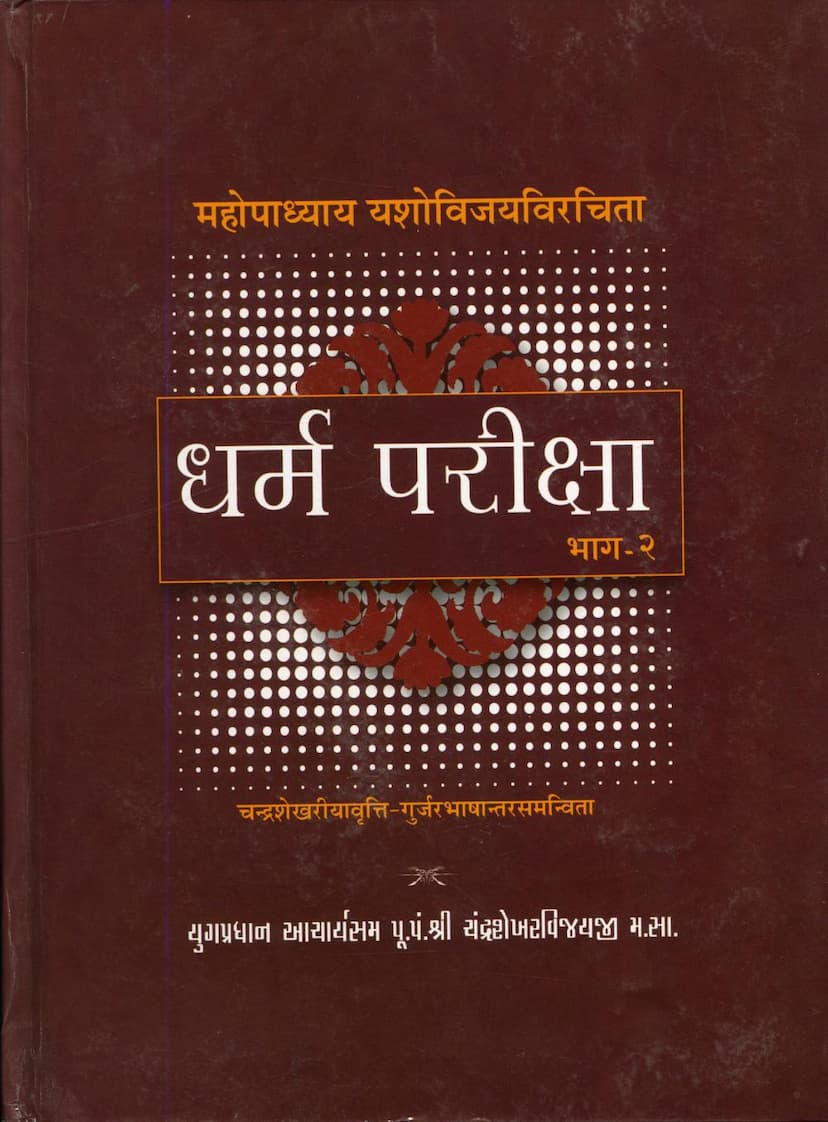Dharm Pariksha Part 02
Added to library: September 1, 2025

Summary
"Dharm Pariksha Part 02" (धर्म परीक्षा भाग-२) is a Jain text authored by Chandrashekharvijay, published by Kamal Prakashan Trust. This book is a commentary and critical analysis of the original work "Dharm Pariksha" by Mahamahopadhyaya Yashovijayji. The second part of this work focuses on refuting various "usutras" (false doctrines or misinterpretations) that were prevalent regarding Jain philosophical concepts.
The book delves into several key areas of Jain philosophy, aiming to clarify and establish the correct understanding based on scriptural authority and logical reasoning. Here's a breakdown of the main themes and points discussed in the provided pages:
Core Purpose: The primary aim of "Dharm Pariksha Part 02" is to rigorously examine and refute incorrect doctrines ("usutras") concerning fundamental Jain principles, particularly related to the concept of mithyatva (wrong belief) and the classification of beings (bhavya and abhavya). The commentary by Chandrashekharvijay aims to make Mahamahopadhyaya Yashovijayji's complex arguments accessible to sincere seekers of Jain doctrine.
Key Concepts and Refutations:
-
Usutras (False Doctrines) vs. Sutras (True Doctrines): The book systematically addresses and refutes several incorrect assertions, including:
- Usutra: Abhavyas (those who will never attain liberation) can only have anabhogik mithyatva (mithyatva due to lack of awareness).
- Sutra: Abhavyas can have both anabhogik and abhigrahik mithyatva.
- Usutra: All abhavyas are inherently avyavahari (those who do not engage in worldly transactions/activities).
- Sutra: Abhavyas who have exited the primordial subtle nigoda (a state of single-sensed beings) are vyavahari.
- Usutra: Badar nigoda (gross single-sensed beings) are always avyavahari.
- Sutra: Badar nigoda are in the vyavahararashi (realm of worldly transactions) and are vyavahari.
- Usutra: Subtle earth, water, fire, etc., are also avyavahari.
- Sutra: Only primordial subtle nigoda are avyavahari; subtle earth, etc., are vyavahari.
-
Classification of Mithyatva: A significant portion of the text elaborates on the five types of mithyatva, providing detailed definitions and distinctions, which the author claims are often not clearly explained elsewhere:
- Abhigrahik Mithyatva: Adherence to one's own beliefs without proper scriptural investigation, often based on family tradition.
- Anabhogik Mithyatva: Wrong belief arising from ignorance or lack of proper understanding.
- Abhiniveshik Mithyatva: Wrong belief held by those who have lost true faith (samyaktva).
- Sanshayik Mithyatva: Doubtful or wavering belief, particularly regarding scriptural pronouncements.
- Anabhogik Mithyatva: (This is mentioned twice in the text provided, which might be a repetition or refer to a different nuance of anabhogika).
-
Role of Ignorance and Guru's Guidance: The text discusses how even those with true faith (samyaktva) can fall into wrong beliefs due to ignorance (anabhog) or the instructions of a guru (guruniyog), even if the guru's teachings are contrary to scripture. It also clarifies the distinction between true and false reliance on a guru.
-
Arguments and Counter-Arguments: The book engages in detailed dialectical arguments, presenting a point, then refuting it with scriptural evidence and logical reasoning, and then addressing potential counter-arguments. This is evident in the extensive commentary by Chandrashekharvijay on the original verses of Mahamahopadhyaya Yashovijayji.
-
Kaya Sthiti (Duration of Existence in Different States): The text touches upon the concept of kaya sthiti, which refers to the lifespan in different stages of existence, providing specific durations in terms of pudgal paravartas and sagaropamas for various life forms, including nigoda, vanaspati, and sensory beings. Understanding kaya sthiti is presented as crucial for grasping the intricacies of mithyatva and bhavyatva.
-
The Nature of Bondage and Liberation: The text implicitly critiques viewpoints that suggest attachment to worldly rituals or the mere outward appearance of asceticism (dravya-linga) without inner conviction (bhava-linga) can lead to liberation. It emphasizes the role of correct understanding (samyaktva) and inner transformation.
-
Interpretation of Scriptures: A significant effort is made to interpret scriptural passages accurately, differentiating between primary meanings and the intentions of the ancient authorities (praman) to avoid misinterpretations (usutras).
Commentary and Structure: The work features the "Chandrashekharia Vritti" (ચન્દ્રશેખરીયા ટીકા), a commentary and Gujarati translation by Pandit Shri Chandrashekharvijayji. This commentary is designed to explain the original Sanskrit text of Mahamahopadhyaya Yashovijayji, making it understandable through detailed explanations and analyses of words and concepts. The preface highlights the difficulty of the task and seeks forgiveness for any printing or conceptual errors.
Overall Significance: "Dharm Pariksha Part 02" is presented as a vital text for those seeking a deep and accurate understanding of Jain philosophy. It aims to guide sincere practitioners in distinguishing between correct doctrines and misinterpretations, thereby strengthening their spiritual path. The detailed refutations and clarifications underscore the importance of rigorous study and intellectual discernment in spiritual pursuit.